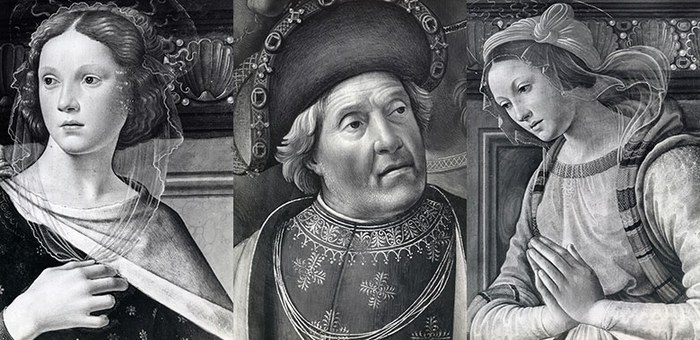Patrons for Ghirlandaio is a special project consisting in scientific cataloguing, study and an online enhancement of the Fahy Photo Archive’s photographic core collection on Domenico Ghirlandaio. This set of material forms a high point in Everett Fahy (1941-2018)’s archive, donated at the Zeri Foundation in 2017.
There are 1,542 photographs entirely digitalized and catalogued. As of December 2021 all images are available in the Zeri Foundation online catalogue, the most importan free access database on Italian Art History, at this link
Thanks to a generous contribution from Emanuela and Silvano Merlatti.
A CORE COLLECTION OF VALUE
Fahy was at the start of his studies at the University of Virginia and barely 20 years old when he met his mentor John Pope Hennessy and focused his research on Tuscan Renaissance painting. One of the artists he explored most fully in the course of his career was Domenico Ghirlandaio (1448-1494), a leading light in Lorenzo il Magnifico’s Florence and head of one of the period’s most prolific workshops.
It was a subject that Fahy returned to time and again: his Harvard PhD thesis, presented in 1968 and published in 1976 after ample revision under the title Some followers of Domenico Ghirlandaio, catalogues the works of over 20 painters growing up in the shadow of the great master. Fifty years on and more, this text is still of basic importance for the study of Tuscan figurative art of the Quattro- and Cinquecento. Though it does not dwell at any great length on the figure of Ghirlandaio himself, it is nonetheless useful in focusing on his stylistic development. As the preface puts it, «only through a clear understanding of admittedly second– or even third-rate painters is it possible to arrive at a clear conception of the truly great masters».
Fahy later went on to publish many important monographic articles on Ghirlandaio (including Michelangelo and Domenico Ghirlandaio, in Studies in late medieval and Renaissance painting in honor of Milliard Meiss, I, New York 1977, and Ghirlandaio copying Memling, in Invisibile agli occhi, Florence 2007), and accompanied them by constant updates to the subject in his photo archive.
The range of that archive on Domenico Ghirlandaio is truly enormous: 19 box files contain over 1,500 photographs documenting the painter’s corpus, divided into various folders according to place of execution.
The largest relate to the major cycles of of Florentine fresco dating from the 1480s and 1490s, such as the Cappella Tornabuoni in Santa Maria Novella (326 photos), the Cappella Sassetti in Santa Trinita (159), the Sala dei Gigli in Palazzo Vecchio (55). On all of these Fahy possessed precise and thoroughgoing iconographic documentation, thanks to his constant correspondence with the local Superintendency.
Besides these, there are envelopes relating to Ghirlandaio’s graphic output (120 photos), which contain a wealth of personal notes and novel information of great use to scholars of the subject.
In addition to the photographic material are some files full of annotations, photocopies and transcriptions of ancient documents which were intended to flesh out a monograph on Ghirlandaio. Fahy actually began work on this in the early 1990s, but got no further than some early sections, unfortunately. Only a few chapters exist of the project, together with part of the photographic apparatus already divided into separate envelopes and complete with captions – enough to suggest the monumental scope of the proposed work which would have been his magnum opus.
